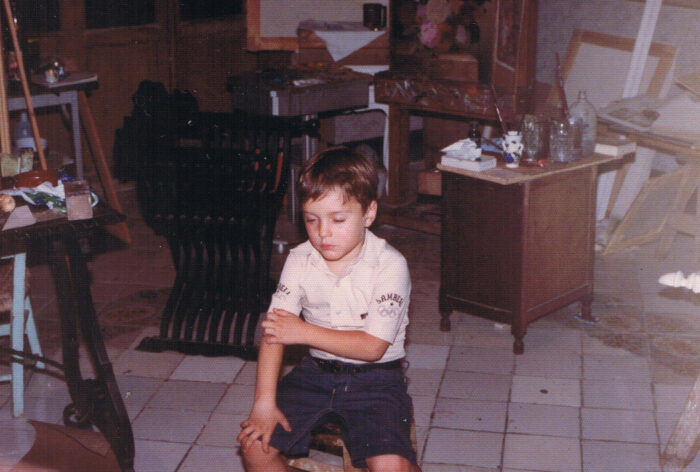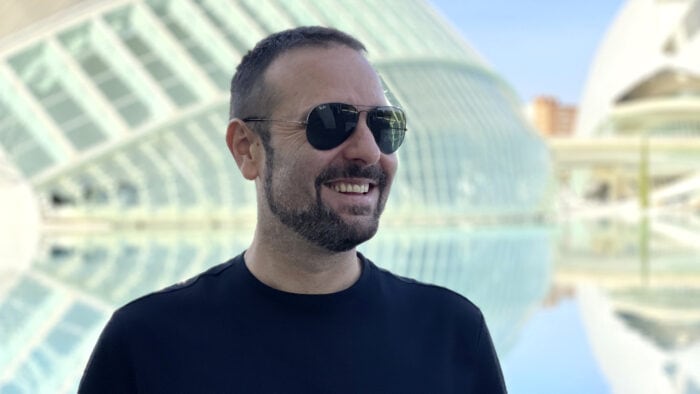JM Blay is a creative director, director, and founder of the creative studio and production company Blay Studio, based in Valencia (Spain).
He has more than 20 years experience in the creative industry, collaborating with renowned studios and agencies worldwide. He’s developed projects for a who’s who of lifestyle, tech and entertainment brands, including Netflix, Marvel, Sony, Nikon, Panasonic, Lenovo, Reebok, and Adobe.
JM also has a degree in Fine Arts, a master’s degree in Audiovisual Communication, and a PhD in Motion Graphics. His work has been recognised in specialised magazines, and he’s been lecturing at universities and festivals worldwide.
But who is JM Blay?
Hi JM. Can you fill us in on your Motion Design background and what led you into the industry?
I’ve been doing creative things since I was born. I was lucky enough to be surrounded by all sorts of creative people growing up.
My father and grandfather were both artists, so art has always been a big part of my life.
I was born in Valencia, Spain, and when I was seven years old, my family moved to Guadalajara, Mexico, where we lived for six years. Both cultures had a big impact on me.

JM Blay, age 6, in his father’s studio
Music and visual arts are my two passions. So when it was time for college, I had to make a choice. I decided to go all-in on visual arts and keep music as my personal thing. The only real option I had back then was to study Fine Arts.
When I started university, I began working at the same time. I was totally convinced that I’d rather make money doing what I’m passionate about rather than treating it as just a hobby, and working some boring job that has nothing to do with my interests.
My first creative job was making decorations for a chain of Mexican restaurants while simultaneously selling my sculptures, paintings, and drawings.
From there, I moved on to working in set design for films and became the creative director of a visual effects company.

Works created by JM Blay, studying Fine Arts
I made the leap to advertising and landed the role of creative director at a renowned digital agency in Madrid, Spain, where I started working for big brands.
When I left that job, I decided to start my own studio, Proxim Design, which I worked on for about five years.
Even though the market had labeled us as a web design studio, my heart was set on diving into motion graphics. Also, up until that moment, I had been trying to handle the whole balancing act of studying and working simultaneously, and let me tell you, it was a real struggle.
So, I made the tough call to shut down the studio, so I could dedicate my full attention to wrapping up my doctoral thesis and following my passion for motion design.
Tell us about your PhD.
My PhD is on Design in the specialty of Motion Design and, specifically, in the work of Kyle Cooper.
I emailed Kyle asking if he’d be up for participating and supporting my research. And you won’t believe it, but his response was a single word: “Yes.”
It’s the briefest email I’ve ever gotten, but man, it’s the one that has truly shaped my career the most.
So, I went to L.A. to do my research. I’ll always be grateful to Kyle Cooper; he opened the doors of his studio, Prologue Films, to me and answered all my questions about the industry.
While I was in Los Angeles, I contacted more professionals in the industry like Garson Yu, Danny Yount, Richie Adams, Jamie Caliri, and many more. Imagine being able to ask all these professionals anything you want.
When I returned from Los Angeles, I dedicated six months to writing my thesis. I submitted it, defended it, and obtained my doctorate. Once it was completed, I decided to emigrate to London and start a new path there.
Can you tell us more about your experience in London?
I arrived with very little money, just enough to survive a couple of months. I didn’t know anyone there, so I wrote hundreds and hundreds of emails until I got an interview.
I was looking for a permanent job in a company, but the first opportunity that came up was freelance work, and my first client was NBC Universal. You can imagine how amazed I was. After that, I started to have a constant stream of freelance projects.
London has been the place that propelled me forward professionally. I stayed there for about eight years and was fortunate to work for top studios and major clients.
I started as a motion designer and eventually began taking on art direction jobs as well. Gradually, I specialised in directing projects and in creative direction.
When and why was Blay Studio created?
I was freelancing as an independent director in London, and every time I joined a company, they’d be like, “Hey, can you bring in some freelancers to help you?”
So I thought, why not turn this into a business model?
Blay Studio is a creative studio and production company with only one employee, me. {Laughs}.
The rest of the team members are freelancers hired on a project-by-project basis. This allows us to tailor the team to the specific needs of each project, bringing in the right mix of skills and expertise.
And what do you do?
We create high-end motion graphics and 3D, often used in film and television, advertising, and other industries where visual storytelling and impact are key.
We can do 100% of the steps needed to complete a project, from ideation to delivery, going through to mood boards, concepts, style frames, storyboards, animatics, editing, VFX, colour grade, etc. Including final exports in any format.
Do you still freelance?
Occasionally. I still engage in the enjoyable task of generating ideas and crafting style frames for films, which, in my opinion, is the best part of a project. I enjoy working on film titles and creating special motion graphics sequences for other companies.
Clients appreciate people who can generate ideas and see them through to completion while being mindful of the budget and timeline constraints. Well, at least that’s what they often tell me.
What projects are you most proud of?
I’m proud of lots of projects, but if I had to highlight some, it would be Dare To Roam and Washi. Both have recently been featured on Motionographer.
NYC-based agency Harper + Scott approached me to create an animation for the launch campaign of Dare to Roam, a new accessories brand specialising in antimicrobial bags founded by Ciara Princess Harris and themselves. The idea was to create a beautiful and dynamic animation to show the antimicrobial technology used to make the bags.
This project was special because the client trusted me and gave me a lot of creative freedom, which was really fun.
On the occasion of the Imadate Art Fair in the prefecture of Echizen in Japan, I was invited to create an audiovisual piece for an art exhibition for the Echizen Museum. It was about Japanese handmade paper, as always, but that year was the first time they were inviting artists from different artistic disciplines to show their view of Washi using their own visual narratives.
The piece I created is a free interpretation of the ancient hand-made process that is Washi. I approached this as an experimental project, finding a narrative in the journey that is the process of paper-making.
I showed the steps I thought were most interesting, focusing on the natural materials and the paper rather than the human action.
This project is special because I was invited as an artist to create something entirely by myself, as I used to do when I was working as a fine arts artist back in the day. I really enjoyed all the experimentation.
Take us through your process. Are there certain things you do every time, no matter the project?
Every project is different, but essentially I always follow the same steps:
Research and mood boards. Initial ideas with storyboard. Style frames and animatics. Motion tests for special shots. Production. VFX. Edit and colour grade. Export the project.
Have you had any ideas that have never quite come to fruition? If so, what? And why didn’t they work out?
My career is full of failures, hehehe.
But here’s one that really stands outs.
I worked as a freelancer in a big studio in 2013 that assigned me to create some styleframes for a project based in space, a theme I was really keen to work on.
After the client saw the styleframes, they loved my ideas. So I ended up directing a motion graphics video for the project.
What was the project?
It was a Lady Gaga concert that would take place in space with Virgin Galactic.
As you can imagine, I was super excited about where this would go.
Unfortunately, Virgin Galactic crashed the space ship so they cancelled the whole thing.
I also did some Christmas Idents for BBC3. They ended up moving the whole channel online, though, so my work was never aired.
Can you talk about the importance of personal projects for creatives?
For me, it’s essential.
Clients are not the sponsors of your art. When you work on a client project, you need to adapt everything to the needs of the client.
When I feel the yearning to test new ideas or to create something that I want, I do personal projects.
Do you have any advice for creatives on pursuing their dream projects?
While studying Fine Arts, I encountered two types of individuals:
- Those who constantly talked about their brilliant ideas and amazing projects in development.
- Those who simply showcased finished work.
For me, striving to be part of the latter group is the key to achieving your dreams.
Just work, work hard, and then work harder. Finish projects and do it again and again, and at some point, you’ll be able to create something nice.
At least, that’s what I aspire to do.









